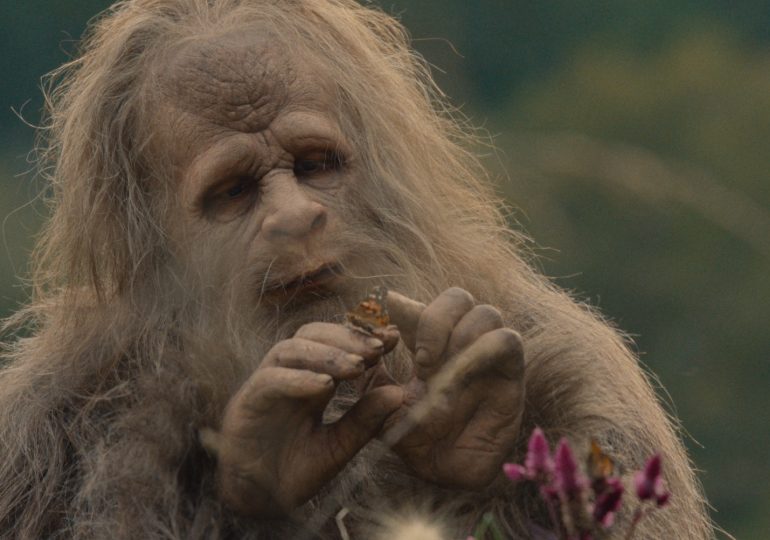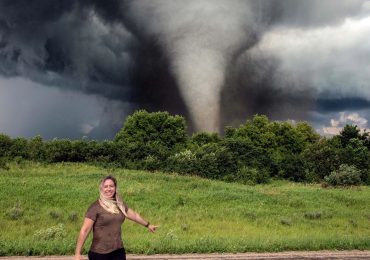There’s a kernel of poignance at the heart of Sasquatch Sunset, a film in which a family—or something—of four apelike creatures wander through the forests and mountains of what appear to be the California Redwoods. In spring, two of them mate—we see them rutting dutifully in the grass, as the other two look on with expressions we can’t quite read, probably a mingling of curiosity and jealousy. One of the elder members appears to be in charge of testing the local berries and mushrooms for possible toxins—an alluring, comically cartoonish red-and-white toadstool ultimately leads to trouble. The child member of the group attaches himself hungrily to his mother’s breast—there’s just one female in this little crew—and the glassy look in her eyes pretty much conveys what we’re thinking: Isn’t he a little old for this? These creatures, tall, shaggy and shambling, are versions of the possibly imaginary beast commonly known as Sasquatch or Bigfoot. But in the logic of Sasquatch Sunset, they’re undeniably real, and they’re very much like you and me. Their existence also seems extremely fragile: just one false step into a steel-jawed trap could wipe their tribe out forever.
[time-brightcove not-tgx=”true”]
Sasquatch Sunset was directed by David Zellner and Nathan Zellner, whose previous film credits—in some combination of writing and directing—include the eccentric western Damsel (with Robert Pattinson and Mia Wasikowska) and Kumiko, The Treasure Hunter, about a Tokyo woman who believes an old VHS copy of Fargo holds the key to escaping her humdrum life. Sasquatch Sunset is brushed with a sense of whimsy, and lashed with heavy doses of slapstick and toilet humor: aside from the aforementioned lusty fornicating, there is much hooting, grunting, and passing of gas, as well as a scene in which the Sasquatch discover a paved road and, feeling both terrified and territorial, consecrate it with rivers of pee and a few dollops of poo. Maybe this is your thing, and maybe not, but either way, consider yourself forewarned.
But maybe the bigger gimmick of Sasquatch Sunset is that there are serious actors encased in these fur-and-prosthetic getups: Jesse Eisenberg and Riley Keough star as the middle-aged male and female; Christophe Zajac-Denek plays the junior Sasquatch, while David Zellner is the elder—at one point he gazes longingly at Keough Sasquatch and subsequently tries to mount her, resulting in outrage from the rest of the group.
This is just the way things go in Sasquatch world: It may seem like a kind of wild, wild west, but it’s really a mini civilization unto itself, and there are rules. Though at first it’s hard to tell the Sasquatch apart, their personalities emerge quickly. In a scene where tragedy strikes, Keough Sasquatch expresses exasperation, followed by muted, slow-burning grief—it’s all there in the soulfulness of her eyes. There’s no doubt these actors are working their tails off, even in Sasquatch costumes that bear no tails.
At Sundance, where the film premiered, audience members reportedly walked out in sizable numbers, turned off by the film’s myriad gross-outs. But the real problem with Sasquatch Sunset is that it’s distancing, in an art-project way. The movie is just too coy, too overt in the way it signals when we’re supposed to be appalled and when we’re supposed to be moved; it advertises its weirdness even as it strives to convince us how much these Sasquatch are like you and me. But at least it’s handsome-looking: cinematographer Mike Gioulakis makes the most of woodsy vistas and sunrises full of promise. To see the Sasquatch crew tramping across a ridge, outlined against a pearlescent sky, is to grasp the fragility of their existence, and of ours. The difference is that we know better than to pee in the road, though admittedly, that’s a pretty low bar.
Leave a comment








